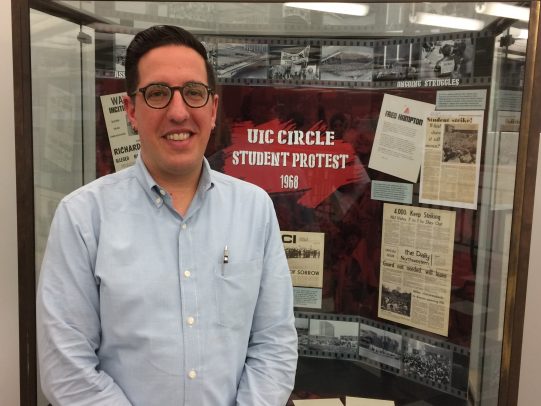Library exhibit highlights historical UIC student protests
A new exhibit on campus recalls a time that rocked the nation, Chicago and the lives of UIC students 50 years ago.
“Division and Possibility: UIC Circle Student Protest 1968,” is on display on the second floor of Daley Library through November. The project highlights historical documents from university archives, the Richard J. Daley Collection, newspapers, and other papers donated to the university to show how the UIC community responded to and influenced local and global events from 1967 to the early ’70s, years marked by a Democratic National Convention in Chicago, Martin Luther King Jr.’s assassination, the Vietnam War, and many riots and protests.
After studying historically significant issues last semester in the Honors College course “City at a Crossroads: Local, National, and Global Politics in Chicago, 1968,” undergraduates curated the exhibit and wrote captions for select pieces.
“The students thought [the materials] were either representative of a certain issue or they made a particular point,” said David Greenstein, visiting lecturer for special collections and university archives. He explained that students in the late ’60s at UIC, then called the Circle Campus, were civically engaged, voicing their opinions on political and justice issues while challenging the university itself to be socially responsible.
Artifacts demonstrate the major role students played in bringing the Democratic National Convention to Chicago. Photos and news clips show people gathering on campus to mourn Martin Luther King Jr.’s death and protest the U.S. invasion of Cambodia. Flyers, articles and opinion pieces reflect the community’s thoughts on the war, unjust treatment of black students, and violent strategies city officials enforced to stop riots. One document showcases outrage over the on-campus recruitment efforts of the Dow Chemical Company, then the U.S. military’s supplier of napalm.
“Free speech, equality, police brutality, the university treating different groups fairly, and the way students are taking the leading role in some protest movements, those are still some important issues we’re seeing today,” Greenstein said.
“I just hope it builds an understanding of how things were then and how they are now,” added Athena Appavu, a co-creator of the exhibit and student in LAS, “to think about what we can do as a university and community to push things in the right direction.”
Categories

